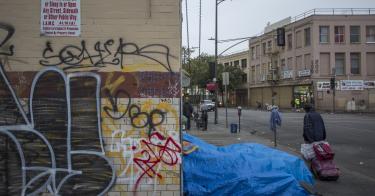There's a new American poverty, and it's spreading through every corner of our nation.
The visuals are familiar: boarded-up homes, abandoned downtowns and shuttered factories. But underneath the visible signs of economic decline, a new social and cultural order has quietly established itself in all of the forgotten cities of the American interior.
I spent five years documenting three of these communities—Youngstown, Ohio; Memphis, Tennessee; and Stockton, California—for a feature documentary called "America Lost." Fifty years ago, all three were exemplars of economic and social progress. What happened next has become conventional wisdom: the old industrial economy was automated and outsourced, the new high-growth industries were centralized in coastal megacities and places like Youngstown, Memphis and Stockton fell into a half-century of decline.
But this is merely the beginning of the story. As I demonstrate in the film, the new American poverty is not primarily an economic phenomenon—it has become a social, familial and psychological problem that reaches the very foundations of our social order.
American communities have always navigated changing economic structures, but this is the first time that the social fabric itself has been shredded. Since Daniel Patrick Moynihan's warning in 1965, the "tangle of pathology"—family breakdown, labor force dropout and chronic poverty—has wrapped itself around every region and demographic group in the country. It is now the dominant reality for more than 50 million Americans.
At the neighborhood level—which is to say, the level of human experience—the statistical portrait is devastating. In Youngstown's 44509 ZIP code, 41% of all working-age men are unemployed or out of the labor force, and 69% of all families are headed by a single mother. In Memphis' 38126 ZIP code, the numbers are even worse—only 20% of all working-age men are employed full-time throughout the year and, out of nearly 6,000 total residents, there are only 10 nuclear families.
In short, the process of atomization that Moynihan feared has reached its grim conclusion. For people in these neighborhoods, the norm of intact families, steady employment and community participation has vanished.
What can be done? In the recent debate about what to do with America's "forgotten cities," policymakers on the left and right have focused on how to revive these places economically, but this framing misses the point. The reality is that, despite a half-century of debate, neither side has managed to present a viable solution to the problem of economic and social decline.
The dominant liberal proposition—welfare state intervention—has failed to improve conditions in these communities; if anything, it has solidified them. At the same time, the dominant conservative proposition—targeted tax cuts and moral exhortation—has lost the cultural foundation that would make it meaningful.
Unfortunately, as the ideas of both left and right have exhausted themselves poitically and empirically, the status quo remains. The United States continues to spend more than $1 trillion per year on means-tested benefit programs, and policymakers engage in a fruitless debate about "opportunity zones" and "expanded benefits," neither of which would address the deeper social pathologies in places like Youngstown, Memphis and Stockton.
And yet, despite spending five years treading across this vast graveyard of American social institutions, I concluded my work on "America Lost" with a sense of hope. Not in any grand scheme or policy proposal, but in the innate capacities of human beings.
Contrary to the approach of the social scientists, who would reduce man to a mathematical variable, I caught a glimpse of the inner workings of human inspiration, which defies the rational and the mathematical. I watched a hardened felon break down in tears about his scattered family. I saw a single mother clutching her daughter's high school diploma. I saw the tattooed hands of a wayward father bring his newborn son into the world.
Ultimately, although the social institutions in America's forgotten cities have been battered down for half a century, there is something inside the human spirit that refuses to forget the meaning of faith, family, and community. This should be the starting point for policymakers: how to remove the obstacles to these universal human impulses. Only then will we see the chance for widespread renewal.
This piece originally appeared in the Quad-City Times




